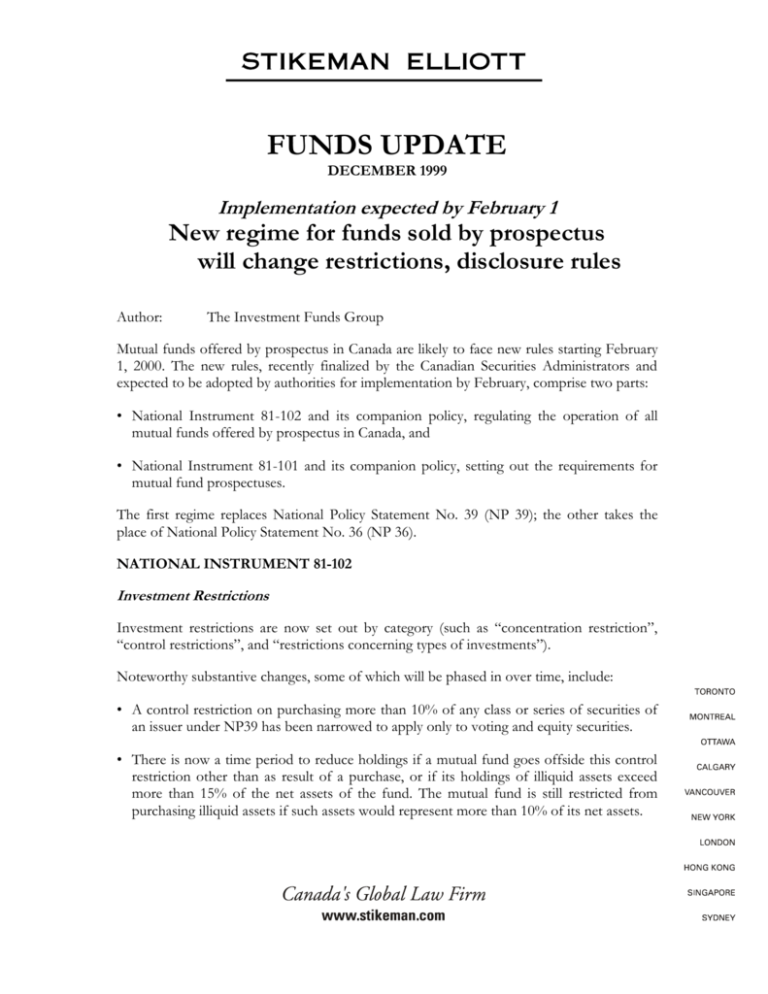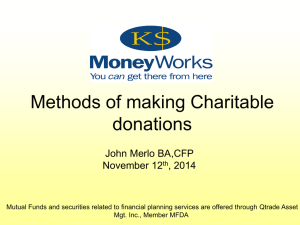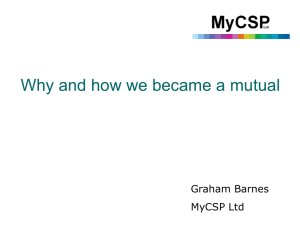Stikeman Elliott 1 FUNDS UPDATE DECEMBER 1999
advertisement

FUNDS UPDATE DECEMBER 1999 Implementation expected by February 1 New regime for funds sold by prospectus will change restrictions, disclosure rules Author: The Investment Funds Group Mutual funds offered by prospectus in Canada are likely to face new rules starting February 1, 2000. The new rules, recently finalized by the Canadian Securities Administrators and expected to be adopted by authorities for implementation by February, comprise two parts: • National Instrument 81-102 and its companion policy, regulating the operation of all mutual funds offered by prospectus in Canada, and • National Instrument 81-101 and its companion policy, setting out the requirements for mutual fund prospectuses. The first regime replaces National Policy Statement No. 39 (NP 39); the other takes the place of National Policy Statement No. 36 (NP 36). NATIONAL INSTRUMENT 81-102 Investment Restrictions Investment restrictions are now set out by category (such as “concentration restriction”, “control restrictions”, and “restrictions concerning types of investments”). Noteworthy substantive changes, some of which will be phased in over time, include: • A control restriction on purchasing more than 10% of any class or series of securities of an issuer under NP39 has been narrowed to apply only to voting and equity securities. • There is now a time period to reduce holdings if a mutual fund goes offside this control restriction other than as result of a purchase, or if its holdings of illiquid assets exceed more than 15% of the net assets of the fund. The mutual fund is still restricted from purchasing illiquid assets if such assets would represent more than 10% of its net assets. STIKEMAN ELLIOTT 2 • A mutual fund is now expressly permitted to purchase an interest in a loan syndication or loan participation if the mutual fund is not required to assume any responsibilities in administering the loan. • A mutual fund is now expressly permitted to enter into swap agreements for hedging or non-hedging purposes in accordance with the provision governing the use of “specified derivatives” (see next section). Specified Derivatives The old NP 39 nomenclature of “permitted derivatives” is gone. The term used in the National Instrument is “specified derivatives”, but the approach to the use of these instruments has not changed significantly. One material addition is a concentration-type restriction that limits derivative exposure with any one counterparty. Manager liability The agreement or declaration of trust covering the services of the mutual fund manager is now required to make the manager (or a party carrying out the manager’s duties) responsible for any loss resulting from failure to act honestly, in good faith, and in the best interests of the fund, or to exercise the degree of care that a “reasonably prudent person” would. The instrument also precludes a mutual fund from relieving the manager, or any person retained by the manager, from liability for failing to meet these standards. Approvals The National Instrument provides that no person (or affiliate) can act as a manager of a mutual fund as a result of acquiring control of a manager unless the securities regulator has approved the change and all securityholders have been notified at least 60 days before the change. Timely Disclosure The National Instrument imposes timely disclosure requirements for certain “significant changes”, equivalent to “material changes”, in the affairs of the mutual fund. A “significant change” in the fund’s business, operations or affairs is one that a reasonable investor would consider important in determining whether to purchase or to continue to hold securities of the mutual fund. The Companion Policy notes that the change of portfolio manager would generally constitute a significant change. Incentive Fees STIKEMAN ELLIOTT 3 Under NP 39, a mutual fund required the prior approval of the securities regulatory authority to pay incentive fees. The National Instrument permits a mutual fund to pay incentive fees, with a requirement that they be tied to a benchmark or index reflecting the fundamental investment direction of the fund. Performance Data A number of the requirements around the use of performance data have changed. For example: • standard warning language has been changed, and rewritten in plain language; • specific requirements are included for principal-protected funds; • “young funds” (funds which have been offered by prospectus for less than one year) can only use performance data in reports to securityholders; and • performance data may now be used in radio and television advertisements. Management Expense Ratio In calculating the management expense ratio for a fund, the National Instrument will require that all non-optional fees, charges and expenses paid by investors outside of the fund be included as expense. This was not required under NP 39. Further, rebates for expenses provided to the fund or an investor by a manager cannot be reflected in calculating the management expense ratio. Previous Exemption Orders At the time of filing a renewal prospectus, funds should draw the regulators’ attention to any exemption orders being relied upon. The National Instrument provides that any exemption orders, waivers or approvals granted under NP 39 will continue in respect of the substantively similar sections of the National Instrument. Other changes The new regime also includes changes to operation of trust accounts, deadlines for filing of compliance reports, and timing requirements for payment of sales and redemptions. Transition The National Instrument incorporates a few transitional provisions: STIKEMAN ELLIOTT 4 • sales communications, other than advertisements, that were printed before the end of this year may be used until August 1, 2000, despite any requirements in the National Instrument; • the requirements for liability and indemnification provisions in the declaration of trust or management agreement do not come into force until August 1, 2000 (permitting funds further time to amend these documents). The following provisions will not come into force until February 1, 2001: • the restriction on holding no more than 15% of net assets in illiquid assets; • the requirement relating to derivative exposure with one counterparty; and • the requirements for specific provisions to be included in custodian agreements (permitting funds further time to amend these documents). Pending Amendments The securities administrators are continuing to consider: • permitting securities lending by mutual funds and the use of repurchase agreements by mutual funds; • establishing rules to permit a broader range of “fund of funds” structures; • adopting rules for switches, transfers and error corrections; and • revising requirements with respect to conflicts of interest (i.e. inter-fund trading, principal trading with related entities and trading with related underwriters). These deliberations may lead to the publication for comment of amending instruments in 2000. NATIONAL INSTRUMENT 81-101 The new prospectus system will be mandatory for all publicly offered mutual funds, other than labour-sponsored venture capital corporations, commodity pools and mutual funds listed and posted for trading on a stock exchange or quoted on an over-the-counter market. Plain language must be used in both the prospectus and the annual information form. The National Instrument continues the NP 36 framework of requiring the delivery of a simplified prospectus to investors, and the filing of an annual information form which is STIKEMAN ELLIOTT 5 available to investors upon request. There have, however, been significant changes to disclosure requirements. The most recent annual audited financial statements and interim financial statements are no longer required to be delivered with a prospectus. The financial statements need only be available on request. Funds must either have a toll-free line or accept collect calls for requests, and material must be sent within three business days. The companion policy says that the delivery of prospectuses or documents incorporated by reference by a mutual fund is not a violation of registration requirements if the delivery is made by a non-registered entity. This is a departure from the current regulatory requirements, which would require that such documents be sent only by registered dealers. Simplified Prospectus The simplified prospectus is divided into two parts: Part A (General Disclosure) and Part B (Fund Specific Disclosure). For a prospectus for a family of funds, one Part A can be prepared with a separate Part B for each fund. Investors can be provided with the Part A and all of the Parts B, or the Part A and the Parts B for those funds of interest to the investor. The National Instrument includes several requirements with respect to how the documents are packaged. The National Instrument requires that the headings and subheadings listed in the prospectus form be used and prohibits disclosure other than information specifically required or permitted and educational material. Registration: A General Update Over the last year the OSC has published a number of rules and policies dealing with registration, including: • Draft Rules 35-501 and 35-502 which reformulate OSC Policy Statements 4.7 and 4.8 These rules clarify residency requirements for registrants and which activities of nonresidents will trigger registration requirements, as well as a simplified registration regime for non-residents. • Draft Rule 31-502 and its Companion Policy, which relate to proficiency requirements for registrants and update, amplify and consolidate the proficiency requirements as well as codify certain administrative practices of the OSC. The draft rule would require certain proficiency requirements for compliance officers, impose time limits on the completion of certain proficiency requirements, and seek to harmonize some of the requirements with those imposed by the Investment Dealers Association. STIKEMAN ELLIOTT 6 • New Rule 31-505 that imposes, as a condition of registration, certain requirements relating to new accounts and supervision, imposes a duty on registrants to deal fairly, honestly and in good faith with their clients, and requires each registrant to designate a compliance officer. • Draft Rule 33-503 and its Companion Policy which require registrants to notify the OSC of certain proposed changes and allow the OSC to prohibit such changes, including changes in the registrant’s name, adoption of a trade name, reorganizations and changes in personnel. • IDA Proposed Amendments which would change the proficiency requirements for portfolio managers and associate portfolio managers, through the introduction of a new course – Portfolio Management Techniques – to replace the current CIM II course. COMPLIANCE Crabbe Huson: OSC Action Against U.S. Investment Manager The OSC recently took the unusual step of instituting enforcement proceedings against a U.S. investment manager for failing to comply with Ontario securities laws in respect of accumulations of shares of a Canadian public company. For failure to comply with early warning, insider reporting and take-over bid requirements in respect of acquisitions of shares of Lytton Minerals (now Tahera Corporation), Crabbe Huson was ordered to pay U.S. $120,000 (which was the amount that Crabbe Huson represented to be its profit from management fees attributable to the holdings of Lytton common shares in excess of 10%) and a further Cdn $40,000 toward the cost of the OSC investigation. Mutual Fund Dealer Compliance Issues This past January, the OSC released a summary of its findings from its compliance examinations of Canadian mutual fund dealers. The OSC’s summary of common deficiencies included: • Trust Accounts – commingling client trust funds with other assets, bank reconciliations not prepared, trust account not interest-bearing as required • Books and Records – poorly maintained trade blotters and records, records not readily accessible, salespersons maintaining their own system of records STIKEMAN ELLIOTT 7 • New Client Accounts and Supervision – new client application forms inadequately completed and not updated, new client application forms not reviewed by supervisor • Suitability of Trades and Supervision - supervisor failure to assess suitability of trades, unsuitable trades, lack of supervision of trading, sales practices, and communications • Know Your Client Information – “know your client” information outdated or incomplete • Power of Attorney/Letter of Authorization – lack of supervision of the powers of attorney • Adjusted Liabilities and Minimum Capital – failure to inform the OSC of capital deficiencies, incorrect calculation of minimum free capital • Referral Arrangements – lack of disclosure to clients regarding referral arrangements and commission splitting • Statements of Accounts and Unitholders’ Communications – statements not produced independently of the salesperson, increasing the risk of fraud and falsification • Compliance Function – branch managers not properly supervised by head office, branch offices not regularly visited by the compliance officer INVESTMENT FUNDS INDUSTRY Proposed Changes to Rules for Canadian Mutual Fund Prospectuses The Canadian Securities Administrators (CSA) released a revised draft of National Instrument 81-101 and its companion policy, both setting out proposed new rules on mutual fund prospectus disclosure. It is expected that the new rules will be effective starting January 15, 2000. Changes to the previously published draft rules include: • Use of established nomenclature: The proposed “fund summary” and “fund prospectus” will not be adopted; instead, the current terms “simplified prospectus” and “annual information form” will stay in place • Flexibility has been included to allow fund companies to prepare documents for a family of funds, but deliver only fund-specific information where appropriate • The annual information form is no longer required to repeat information contained in the simplified prospectus STIKEMAN ELLIOTT • 8 There will be increased flexibility as to the order of information and the design of the document Comparative Study of Mutual Funds and Segregated Funds The CSA and the Canadian Council of Insur-ance Regulators (CCIR) recently released a comparative study of Canadian mutual funds and segregated funds as a first step toward harmonizing the regulatory regimes for these investment products in Canada. The study is an interesting and comprehensive survey and is intended to form the basis for discussion among the regulators for the preparation of effective regulation. Trustee Act (Ontario) Permits Trustees to Invest in Mutual Funds Effective July 1, 1999, changes to the Trustee Act (Ontario) permit trustees to invest in mutual funds. Previously, trustees were generally restricted from investing in mutual funds as only specific investments were permitted, and because case law suggested that an investment in mutual funds was an improper delegation of authority by the trustee. The Trustee Act amendments replaced the “legal list” of permitted investments with a “prudent investor” standard of care for the selection of investments. Further, the amendments included a provision that restrictions on the delegation of duties by a trustee do not prevent trustees from “delegating” their investment decisions to the managers of mutual funds. Proposed Changes to Mutual Fund Regulation In 1997 the CSA published for comment draft National Instrument 81-102 and its companion policy, which will replace National Policy Statement No. 39. The CSA has recently published proposed changes to the draft National Instrument and Companion Policy. Proposed changes include: • Permitting mutual funds to use swap agreements • A 5% cushion has been included in the limitation on investing in illiquid securities to provide flexibility for market fluctuation • The CSA have attempted to clarify their view that a non-resident commodity futures adviser to a fund distributed in Ontario is required to register in Ontario • The proposed requirement that securityholders approve a change in control of the manager of a mutual fund have been changed to merely require 60 days’ prior notice to securityholders STIKEMAN ELLIOTT • 9 A number of technical changes have been made to the provisions dealing with derivatives, processing purchase and sale orders, mandatory disclosure and permitted advertising FINANCIAL SERVICE PROVIDERS The MFDA: Where is it Now? The Mutual Fund Dealers Association (MFDA), established in June 1998, has progressed this year toward its recognition as a self-regulatory organization for mutual fund distributors. In April 1999, the MFDA arranged start-up financing, guaranteed by the Ontario, British Columbia and Alberta securities commissions. The MFDA has targeted this fall for the start of the process for formal recognition by securities regulators. Upon recognition of the MFDA, the Canadian Securities Administrators (other than the Commission des valeurs mobilières du Québec) are expected to require membership of all mutual fund distributors and securities dealers in a recognized self-regulatory organization. After the MFDA is formally recognized, new mutual fund dealers will likely be required to join immediately and existing dealers to join over a 12 to 18 month period based on their registration renewal. The rules for MFDA members are expected to be based largely on the recommendations of five industry committees to the MFDA board of directors. The rules, now being prepared by MFDA staff, will be subject to review by the MFDA board and the securities regulators and to a public comment process. Revamping the Exempt Market: A Concept Paper The OSC published a concept paper proposing significant changes to the prospectus and registration exemptions. The concept paper recommends replacing four of the current exemptions – the private company exemption, the Cdn. $150,000 exemption, the seed capital exemption and the government incentive security exemption – with two new exemptions, the “Closely Held Issuer Exemption” and the “Accredited Investor Exemption.” The Closely Held Issuer Exemption would allow issuers to raise a total of Cdn. $3 million through any number of financings. Under the Accredited Investor Exemption, issuers would be allowed to raise any amount of capital at any time from a specified class of sophisticated investors. The proposal includes a recommendation that dealers not be permitted to participate in trades made under the Closely Held Issuer Exemption. The OSC also states that the private placement market should generally be allowed to function without dealer involvement and STIKEMAN ELLIOTT 10 that if investors want the assistance of a market intermediary, the latter should, at the very least, be subject to proficiency and capital adequacy requirements. The OSC’s concept release does not specifically address the situation of international dealers. However, because international dealers are not subject to proficiency or capital adequacy requirements this appears to suggest that the OSC may be planning to restrict, in some way, such dealers from making sales in reliance on the Accredited Investor Exemption. This would be a significant restriction - the Cdn. $150,000 exemption (which the Accredited Investor Exemption would replace) and the existing institutional exemptions are often relied on by international dealers to sell securities in Ontario. We have submitted a comment on the concept paper suggesting that the Accredited Investor Exemption be extended to include trades by registered international dealers. Revamping Distribution Structures: A Position Paper The Canadian Securities Administrators released a position paper prepared by a committee struck to consider and develop policy positions with respect to how securities firms structure their businesses and, in particular, to address the CSA’s growing concern that “non-traditional” business structures being used by firms in the securities industry erode firms’ legal responsibility for their employees and effective supervision. The recommendations, if implemented, will require a large number of firms (and in particular Canadian mutual fund distributors) to restructure their businesses. The recommendations extend to the unregulated financial services provided by Canadian dealers (such as financial planning and the provision of tax advice), and the paper indirectly recommends that these services be subject to regulation. The recommendations include: • permitting referral fees and commission splitting arrangements only through registered entities, with the arrangements precleared by regulators • requiring that the financial planning activities of all salespeople be conducted through the registered dealer, and that minimum proficiency requirements be established, increased insurance be obtained, and specified disclosure documents be given to clients and filed with the regulators • amending legislation to impose statutory civil liability on dealers for all of the financial service activities of their salespersons, regardless of structure • permitting principal and agent relationships between dealer and salespeople, provided that the attributes of employee/employer relationships are replicated STIKEMAN ELLIOTT 11 • prohibiting independent contractor relationships between dealers and salespeople • generally prohibiting salespeople from incorporating to conduct financial services activities • imposing restrictions on arrangements whereby unregistered corporations provide services to a dealer and its salespeople • permitting only certain types of “introducing/carrying broker” structures, and requiring that all corporations involved be registered Implementing the broad principles articulated by the Committee would require legislative and regulatory amendments. The Committee also stated that it would look to self-regulatory organizations to implement most of the detail. A simplified prospectus must now include each of the following: • Sales Charge: A table illustrating the fees payable by an investor under available purchase options, if the investment is held for 1, 3, 5 or 10 years and redeemed immediately before the end of each period (an assumed annual rate of return of 5% is to be used for redemption charges). • Dealer Compensation Disclosure: The percentage of management fees paid as compensation to related dealers or for marketing or promotional activities over the last fiscal year of the manager. • Top Ten Holdings: The ten largest holdings of the mutual fund, as at a date within 30 days of the simplified prospectus. • Performance Data: A bar chart of year-by-year returns, a line graph of overall past performance and a table of annual compound returns (specific requirements for performance data are included in both National Instruments). • Financial Highlights: Tabular presentations of the fund’s distributions and net assets value, and certain ratios (including the management expense ratio and portfolio turn-over rate) for the previous five fiscal years. • Illustration of Indirect Expenses: An example of the share of the expenses of the fund borne indirectly by investors (i.e. the fees and expenses of the fund) over 1, 3,5 and 10 year periods, assuming, among other things, a $1,000 investment and a 5% annual return. Annual Information Form STIKEMAN ELLIOTT 12 Significant changes to the required disclosure in an annual information form include: • No Repetition: Information contained in a simplified prospectus need not be included in the annual information form. • Portfolio Adviser: The extent to which individuals employed by the portfolio adviser make investment decisions and any oversight of such persons has to be stated. Individuals principally responsible for the day-to-day management of a material portion of the fund’s portfolio, implementing a particular material strategy, or managing a particular segment of the fund are required to be named along with a description of their business activities over the previous five years. • Fund Governance: A detailed description of the governance of the fund must be included. Policies and practices used to manage risks in connection with derivatives must also be included. • Legal and Administrative Proceedings: Disclosure is required in respect of any material legal or administrative proceedings involving the fund, its manager or its principal distributor. In addition, certain penalties or sanctions (over the previous 10 years) and settlement agreements with regulatory authorities (in the 10 years before the prospectus, but since the National Instrument has come into effect) involving the fund, its manager or its principal distributor, or any of their directors or officers, are required to be described. Transition Any renewal prospectuses filed after the date of implementation (expected to be February 1, as noted above) must be prepared in accordance with the new forms. Funds which are required to file renewal pro forma or preliminary prospectuses in January can elect to follow the National Instrument. Alternatively, if a preliminary or pro forma prospectus is filed before the National Instrument becomes effective, the fund can elect to follow NP 36 for both the preliminary or pro forma prospectus and the final prospectus.






